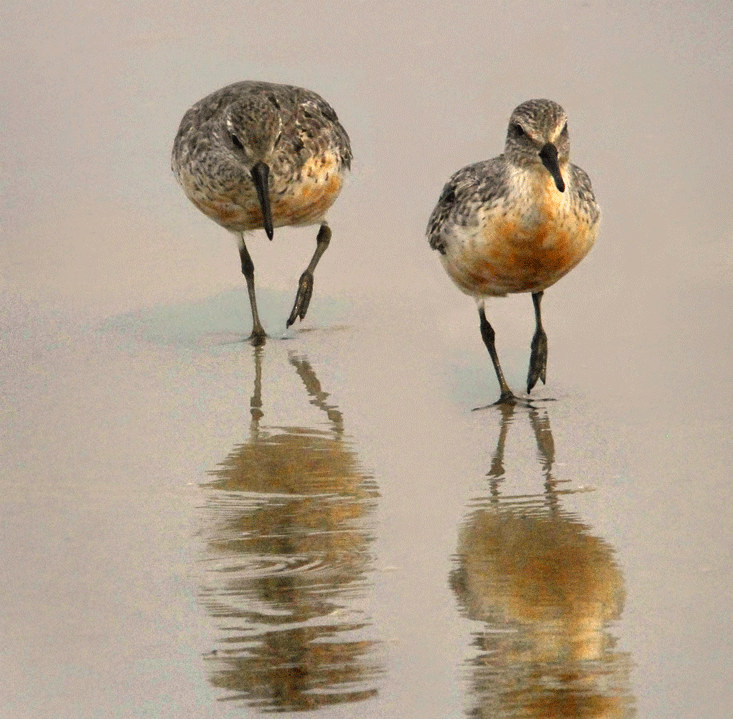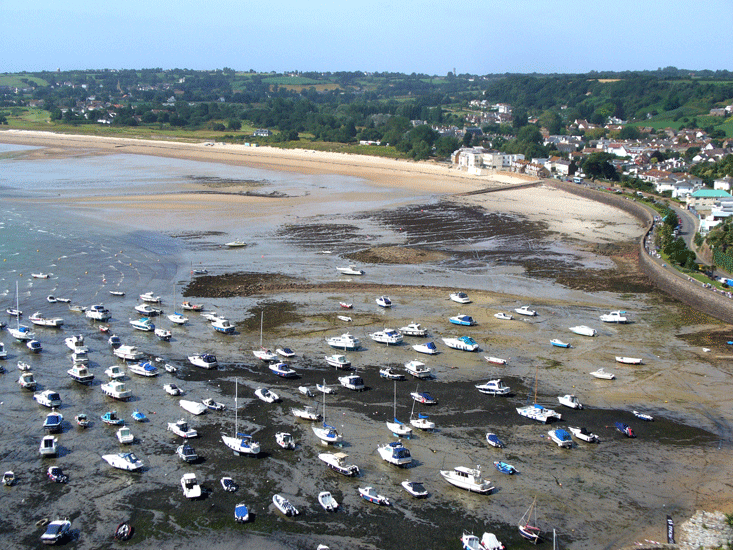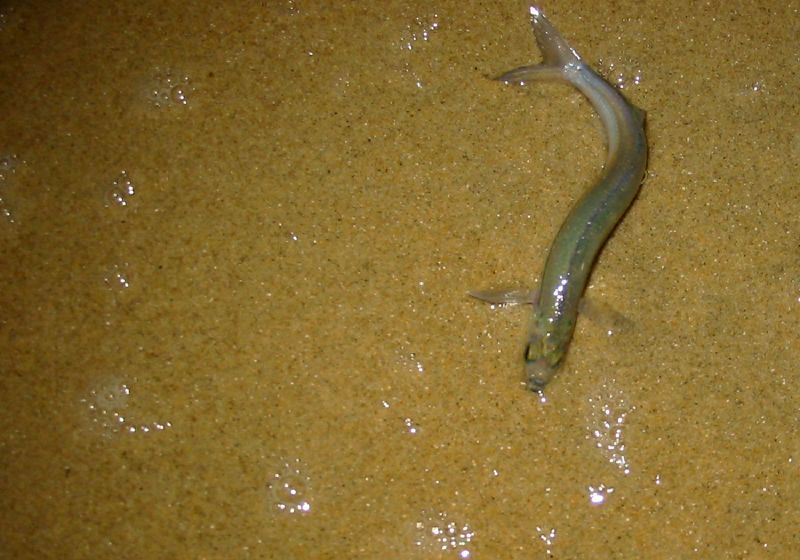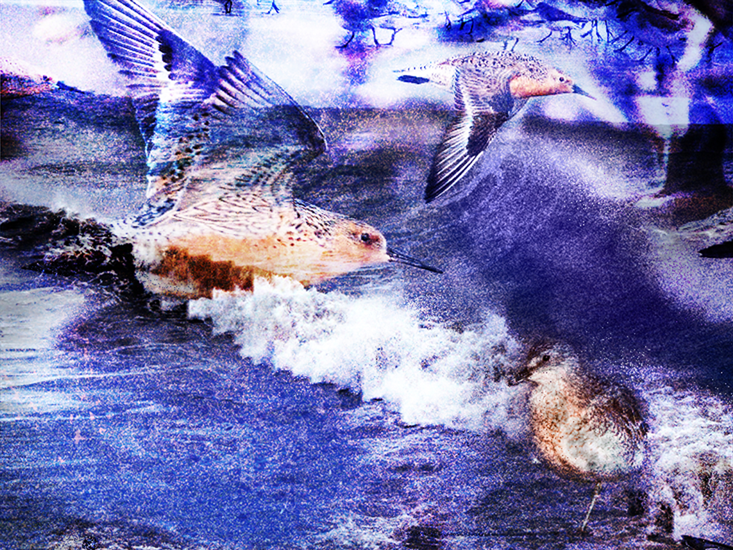The evolutionary attraction of the ocean: how animal biological clocks are synchronized with the tides

In winter, the Icelandic sandboxes flock to the thousands in order to feast on the shores of Wash Bay that are exposed by the ebb. These are medium-sized birds of the suborder sandpipers , dull and unappealing in appearance, white below and sand-colored above. During the mating season, their feathers are colored in a reddish-brown color, but this happens in the Arctic Canada, Russia and other cold climates, where birds spend the summer, and in Britain they are rarely seen. In Britain, the sandboxes are more known for their huge amount.
The sight of their huge flocks fascinates during their flights over feeding places: in my Norfolk, Thames and Severn estuaries , Morecambe Bay and other places where the ebb exposes fairly wide bands of silt. Birds spend an hour or two at high tide, hiding in the vegetation just above the water, and then returning to re-feeding. In Snettisham on the western shore of the Wash, tidal flights of birds of up to 45,000 birds were recorded.
')
The sandboxes behave very characteristic. Some sandpipers fly away at different individual intervals as ebb and flow occurs. Others, such as sandpipers , turn their backs to the water and go, as if unhappily, up the muddy slope from the advancing water. But the sandboxes, perhaps due to the fact that their flocks are very dense, are removed from the spot at the very last moment, when the tide has already reached their paws and threatens to wet their stomachs.
I watch them fly in intricate movements, like a curtain pulled back by a magician. A dense flock is spinning and makes sudden attacks like a single air organism. Having taken off, the birds unite into an egg-shaped cloud not high above the water, and then the flock gains height and takes on even more bizarre forms, as if a pixel flamenco dancer. As the yaws and dives of this cloud, each of its points either becomes bright or dark when the bird's body turns, creating an iridescent and slightly unreal effect. And all this time the birds scream, and their screams overlap, creating a stunning and high white noise.
After resting for an hour at high tide on the shore, the sandboxes return to their task, gradually marching down to the low tide border with outgoing water, looking for food. The returning flock does not look as elegant as it has recently risen; the birds are in a hurry. They disperse along the water's edge. They feed by touch, feeling the vibrations of silt with their long beaks, betraying the presence of the mollusks buried under it. They eat small mussels and heartworms , but are especially indifferent to such representatives of bivalve mollusks as the Baltic maqom and to the sludge snails Hydrobia ulvae. The mollusk makoma lives in the mud in the lower part of the tidal zone, and uses a siphon tube to suck the nutrient material from the wet surface. The silt snail lives in the upper part of the tidal zone, and feeds on algae and organic detritus , such as decaying remains of sea creatures and faeces from which it extracts protein. Such segregation of the main food products of sandboxes is reflected in their eating habits - they peck the surface in search of snails in the upper part of the tidal zone when the tide begins or the tide begins, but they dig up the mud in search of shellfish when the water completely recedes.

Other coastal birds prefer different types of food and therefore behave differently with regard to water. Sandboxes remain on the edge, and dunlins can easily dive after their prey. Avocets use their curved beaks to fumble in shallow water in search of nereis worms and crevelectas. Sandpiper magpies can smash the solid cusps of sea shells with their beaks, resembling a jackhammer. In the Bay of Fundy, up to two million small sandworms stop along the migration path to feast on silt shrimps. This place is a success with them, since invertebrates develop here earlier than usual because of extremely far-receding water, which guarantees a reliable source of food.
In all cases, the behavior of birds is controlled by the ebb and flow. The ritual of sandboxes - food, churning in a flock, rest, returning to the shore - is repeated not at the same time, but about an hour later every day, since it depends on the tidal cycle. When, perhaps in a few days, the tide comes with the arrival of the night, the sandboxes can rest a little longer and abandon the air acrobatics, since the predators that feed on them hunt during the day, but still continue to eat during low tide at night.
The tidal zone is a unique area, a concentrated transition zone between the ecological communities of the sea and land. It is an environment rich in food, but also a tense existence - due to the change of heat and cold, sun and waves. Other habitats are usually limited to climatic regions. But the tidal zone occurs on any bank, and is limited only by ebbs and flows. And the life it supports is almost exactly reproduced around the world, despite the difference in climate.
On the rocky shores, the division into zones is clearly marked on each surface, and you can see graphic evidence of the rigid organization of animals and plants into classes according to their tolerance for diving into seawater or for going out into the air. On such a bank, the land layer of gray color with green moss growing on it serves as the top layer, and the guano spots demonstrate the regular use of these stones by seabirds as perches. Below it is a darker gray layer, brighter pronounced above than below. This is a splash zone, which is often affected by the sea, but does not regularly submerge. Its different color indicates the presence of small algae.
To the lower strata in places where they are not too steep, coastal algae cling. Below them there is a brown layer containing more small and large algae, which covers every tide. The last visible layer, closer to the edge of the ebb tide, again shows a gray stone, to which larger marine organisms cling to - sea ducks , sea plates and large algae. The division into zones is demonstrated not only by these immobile, sessile organisms, but also by a myriad of insects, crabs, coastal birds and other animals running back and forth in search of food in their usual borders.

And this vertical sequence is preserved throughout the world, only the width of individual lanes changes, and sometimes one of them may completely disappear due to unsuitable physical factors, or due to the competition of species. But in general, such a hierarchical organization of life reduces competition. The boundaries of the hardness bands are not inferior to the borders of the countries, and are shifted only in case of unsuccessful coincidences of several events, and then only a little and not for long. For example, storm waves at high tide will temporarily increase the splash zone, and drought of the quadrature tide will dehydrate the species usually living in the high tide zone.
The tidal zone is inevitably threatened by another serious danger - humanity. In many parts of the world, this rich habitat area is declining. As the sea level rises, the sea invades land - and this is a more serious factor than it seems at first glance. Rising sea level by a millimeter can lead to erosion of the land meter. And the development of coastal zones takes them from land. If these two processes are encountered, then defensive structures are built on their border, replacing the shore, dunes and swamp with one concrete fence. Habitat width of 1-3 km is suddenly replaced by a vertical wall, compressing the tidal zone to a few meters.
Other creatures in the process of evolution have learned to use the ebb and flow of more sophisticated ways. For example, the reproduction cycle of the “walking fish,” California grujion (Leuresthes tenuis), is synchronized with spring tides, when the highest tide happens every two weeks, on every new and full moon. Grunion is a small silver fish the size of a sardine with ray-shaped fins. On spring and summer nights at high tide, the sandy beaches of southern California, where fish come to spawn, are suddenly covered with thousands of wriggling creatures.

Scientific observations show that this event is precisely synchronized in order to take advantage of the tides. Everything happens usually in the days immediately after the full or new moon, when the tide is high, but not the maximum. For each subsequent day, in this short period, the tide will gradually decrease, and the caviar set aside by the grunions in the sand will not be washed out with water. And the waves of subsequent tides breaking on the shore plow the sand, as a result of which the caviar does not sink too deep. Over the next 11 days, caviar develops in shallow and moist sand. After 11 days come the big waves of the next spring tide. They begin to blur the sand where the caviar lies. Soon it turns out to be no longer buried in the sand, but dangling in the waves, which is a signal for the hatching of the fry. Usually they hatch shortly before the next full or new moon, as a result of which their chances of descending down the beach to the water until the next tides increase, which will gradually increase.
But that is not all. If spring tides do not reach the eggs spawning in the sand — for example, when the wind lowers the height of the tide — the fertilized calf can delay hatching by two or even four weeks until a more favorable tide comes.
Many sea creatures, including fry of fish, hazelnuts and Colchester oysters, demonstrate a similar synchronization of the reproduction cycle with spring tides and ebbs. But among the gruonians, adaptation is so precisely tailored to the ebb and flow that it can be called an evolutionary miracle. The details of their reproduction cycle indicate their close connection with ebbs and flows. Evidence suggests that the Grueno evolved in this place, and also that since then the tidal conditions of their habitat remain about the same.
Where do animals "know", what will the tide lead to? When scientists began to study this issue, they considered it unlikely that any Gruenoi would have an internal mechanism by which time could be compared for reproduction. Do they feel a rush directly, or react to other stimuli? Something can be inferred logically. It is unlikely that fish attracts the light of the moon to the shore, since they are engaged in this both on the full moon and on the new moon. The fact that reproduction does not occur at the highest tide, but soon after, says that their behavior does not depend on the immediate height of the tide (this moment could be determined by a small change in pressure). The next tide after spawning rocks the eggs, which leads to the release of enzymes that dissolve the membrane of eggs, so that the fry hatch. But the waves could not stimulate the fish to spawn, but otherwise any storm would violate the entire breeding system.
What else is left? Can gravity pull serve as a stimulus? Any kind of force is nothing compared to the change in pressure that fish experience, changing depth, but gravity cannot be completely dismissed. Whatever stimulates this behavior, this phenomenon is definitely not tied to that particular tide, during which the grunions spawn, as the caviar begins to ripen long before that - and also in unison with the phases of the moon.
Author John Steinbeck writes about this riddle in The Journal of the Sea of Cortez , a book about a biological expedition, organized by him and his friend Ed Rickets of the Gulf of California in 1940. "Sea of Cortez" was called their ship, as well as the area where they "hunted". Ricketts, who served as the prototype for the character Dock in Steinbeck’s book " Canning Row ", later wrote a scientific guide on tidal life, based in part on the results of this expedition. Entangled in the roots of mangrove trees with a boat screw and hastily gathering representatives of different species from the shallows that opened at low tide, they discovered amazingly diverse and colorful life in warm waters: crabs and snails, creatures with the names of horrible mythological monsters, such as gorgons, and other creatures such as Serpulids , so little known, that they have only the names given by science. They saw fish that could live without water, at least between the tides, and observed various forms of life, separated by the amount of time spent in the water.

Inevitably, they began to argue about the importance of ebbs and flows for the presence of diversity in life, especially since in the Precambrian period , when single-celled organisms began to evolve into more complex forms, the magnitude of ebbs and flows was much lower than today. . Steinbeck writes: "The attraction of the moon must have been the most important environmental factor for coastal fauna." The weight of their bodies and movement in the sea cyclically changed with the rotation of the Earth. “Imagine the effect of reducing pressure on gonads, full of caviar or sperm, if they are already almost exploding and waiting for a small additional stimulus for discharging.” Steinbeck finds it most interesting that many animals carry some kind of ancestral memory, based on such stimuli, and adjust it to less obvious signals of ebbs and flows - he believes that we are subject to this effect. “The tidal effects are mysterious and hidden in the depths of the soul, and it can be stated that even today the effects of the tides are more pronounced and greater than is commonly believed.”
The question remains of how exactly these creatures feel ebb and flow. They do not float with tide charts, they do not match tides and time in such an artificial way as we do. Either they have a built-in tidal clock, or they directly sense some of the primary or secondary properties of the tides, such as pressure or flow rate of water, or changes in its temperature and salinity.
Perhaps the fact that we have long ago got rid of the tides, makes this problem more difficult than it is. After all, there is nothing surprising in the feeling of animals time. We ourselves obey circadian rhythms, as alarms and news releases remind us daily. Why should the circus rhythm be stranger than the circadian rhythm? Of course, the circadian rhythm has obvious signs of a change in bright sunlight by darkness. But it is obvious to us. And what could be obvious to sea creatures so different from us? We consider the 24-hour rhythm natural, but can these animals not consider the period from 12 hours a little natural, especially if their survival depends on it?
The way the sun controls the daily and annual rhythms of life on land is relatively well known. But the explanation of the rhythmic mechanisms of marine life begins to be built just now. Circadian rhythms are driven by chemical response genes. This means that the rhythm is maintained even in the absence of external stimuli, such as a change in the level of illumination or temperature. The same kind of independent rhythms were observed in sea creatures, but it remains an open question whether these biological clocks are associated with tides, or whether they are a version of circadian clocks that have been adjusted as a result of adaptation to a different period of work.
In 2013, genetics from the University of Leicester received evidence of the existence of specialized circadian-tidal biological clocks. The researchers worked with one of the species of shrimp, Eurydice pulchra, a famous inhabitant of sandy beaches. Disrupting the expression of genes responsible for circadian rhythms, and showing that animals still retained their tidal behavior, the scientists found that tidal rhythms do not depend on the circadian clock. Wood lice have both types of biological clocks: circadian controls of processes such as the appearance of bodily pigment, and circadian tides controlling their behavior in water in response to 12-hour tidal rhythms.
With regards to longer cycles, spring and quadrature tides, experiments give us new explanations of how animals react to them. Austrian researchers used nereid - it was one of the first species in which scientists discovered reproduction cycles tied to spring tides. It is considered a living fossil, because its physiology, behavior and habitat have not changed for millions of years. Unlike grunionov, these worms do not breed every spring tide at a certain time of the year, but do it every month, at a tide in the full moon. This behavior suggests that their circadian-lunar hours can be tied to moonlight, or rather, to its absence, and not to hydrodynamic factors that can affect grunionov. Biochemical reactions, catalyzed by moonlight, may play a role in this behavior. All known biological clocks are somehow connected with either the moon or the sun.
I was completely unaware of the dependence of the Nereids on the lunar cycle, when I picked one of them out of the mud, watching the ebb and flow on the north bank of Norfolk. I saw gulls and curlews that flew in and out that day, but in order to truly appreciate the ebb and flow of these animals, I would have to stay in that place for many days. Our lives are so clearly controlled by the change of day and night, that we are completely unaware of other rhythms different from this, and science begins to understand their science only now.
An excerpt from the book Hugh Eldersi-Williams " Tide: science and stories about the greatest strength on the planet "
Source: https://habr.com/ru/post/403499/
All Articles